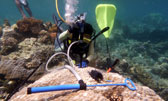





Singapore, 1 Jul 2014 - Scientists at the Singapore-MIT Alliance for Research and Technology (SMART) have reconstructed the history of heavy metal lead (Pb) level and sources in Singapore waters and the Indian Ocean. [See AsiaOne's story on 'Scientists trying to solve lead mystery']
While lead concentrations decreased in the North Atlantic Ocean by almost 10-fold after 1970s with the regional phasing out of leaded gasoline consumption, the opposite has occurred in the surface of Indian Ocean. They have found that lead concentrations in the Indian Ocean and the Straits of Singapore rose from the mid-1970s until early 2000s. This lead concentration has declined since, but the current concentrations are now three times higher than that in the North Atlantic and North Pacific Oceans.
These findings are a result of the measurement of heavy metals such as lead (an indicator of industrial activities in the oceans) in the corals, which were drilled from the Chagos Archipelago, west Sumatra and Singapore’s Jong Island.
Monitoring lead in our marine environments remains an analytically challenging task, and that high-fidelity data is produced from a few inter-calibrated labs such as the one led by Prof Edward Boyle at the Massachusetts Institute of Technology (MIT). Prof Boyle, SMART Principal Investigator, together with Dr Jong-Mi Lee (MIT Postdoctoral Researcher), Dr Intan Suci Nurhati (SMART Senior Postdoctoral Associate) and collaborators from Germany, Indonesia and Singapore’s Nanyang Technological University contributed to this study. See News Release for more.